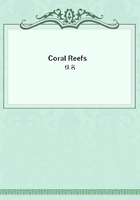
第27章
Reefs of Mauritius.--Shallow channel within the reef.--Its slow filling up.--Currents of water formed within it.--Upraised reefs.--Narrow fringing-reefs in deep seas.--Reefs on the coast of East Africa and of Brazil.--Fringing-reefs in very shallow seas, round banks of sediment and on worn-down islands.--Fringing-reefs affected by currents of the sea.--Coral coating the bottom of the sea, but not forming reefs.
Fringing-reefs, or, as they have been called by some voyagers, shore-reefs, whether skirting an island or part of a continent, might at first be thought to differ little, except in generally being of less breadth, from barrier-reefs. As far as the superficies of the actual reef is concerned this is the case; but the absence of an interior deep-water channel, and the close relation in their horizontal extension with the probable slope beneath the sea of the adjoining land, present essential points of difference.
The reefs which fringe the island of Mauritius offer a good example of this class. They extend round its whole circumference, with the exception of two or three parts (This fact is stated on the authority of the Officier du Roi, in his extremely interesting "Voyage a l'Isle de France," undertaken in 1768. According to Captain Carmichael (Hooker's "Bot. Misc." volume ii., page 316) on one part of the coast there is a space for sixteen miles without a reef.), where the coast is almost precipitous, and where, if as is probable the bottom of the sea has a similar inclination, the coral would have no foundation on which to become attached. A similar fact may sometimes be observed even in reefs of the barrier class, which follow much less closely the outline of the adjoining land; as, for instance, on the south-east and precipitous side of Tahiti, where the encircling reef is interrupted. On the western side of the Mauritius, which was the only part I visited, the reef generally lies at the distance of about half a mile from the shore; but in some parts it is distant from one to two, and even three miles. But even in this last case, as the coast-land is gently inclined from the foot of the mountains to the sea-beach, and as the soundings outside the reef indicate an equally gentle slope beneath the water, there is no reason for supposing that the basis of the reef, formed by the prolongation of the strata of the island, lies at a greater depth than that at which the polypifers could begin constructing the reef. Some allowance, however, must be made for the outward extension of the corals on a foundation of sand and detritus, formed from their own wear, which would give to the reef a somewhat greater vertical thickness, than would otherwise be possible.
The outer edge of the reef on the western or leeward side of the island is tolerably well defined, and is a little higher than any other part. It chiefly consists of large strongly branched corals, of the genus Madrepora, which also form a sloping bed some way out to sea: the kinds of coral growing in this part will be described in the ensuing chapter. Between the outer margin and the beach, there is a flat space with a sandy bottom and a few tufts of living coral; in some parts it is so shallow, that people, by avoiding the deeper holes and gullies, can wade across it at low water; in other parts it is deeper, seldom however exceeding ten or twelve feet, so that it offers a safe coasting channel for boats. On the eastern and windward side of the island, which is exposed to a heavy surf, the reef was described to me as having a hard smooth surface, very slightly inclined inwards, just covered at low-water, and traversed by gullies; it appears to be quite similar in structure to the reefs of the barrier and atoll classes.
The reef of Mauritius, in front of every river and streamlet, is breached by a straight passage: at Grand Port, however, there is a channel like that within a barrier-reef; it extends parallel to the shore for four miles, and has an average depth of ten or twelve fathoms; its presence may probably be accounted for by two rivers which enter at each end of the channel, and bend towards each other. The fact of reefs of the fringing class being always breached in front of streams, even of those which are dry during the greater part of the year, will be explained, when the conditions unfavourable to the growth of coral are considered. Low coral-islets, like those on barrier-reefs and atolls, are seldom formed on reefs of this class, owing apparently in some cases to their narrowness, and in others to the gentle slope of the reef outside not yielding many fragments to the breakers. On the windward side, however, of the Mauritius, two or three small islets have been formed.